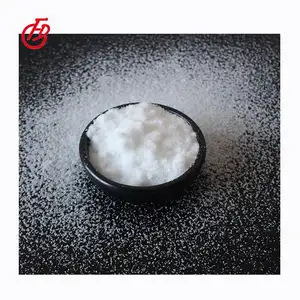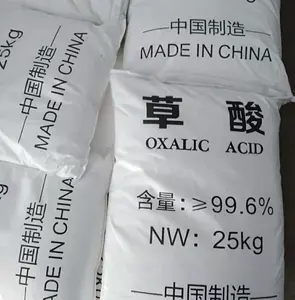Top categories

Energy Chemicals

Flavor & Fragrance

Chemical Reagents

Non-Explosive Demolition Agents

Other Chemicals

Custom Chemical Services

Biological Chemical Products

Painting & Coating

Surface Treatment Chemicals

Catalysts & Chemical Auxiliary Agents

Admixture & Additives

Pigments & Dyestuff

Basic Organic Chemicals

Agrochemicals

Inorganic Chemicals

Coating & Paint
About products and suppliers
What is Oxalic Acid Cost Guide
Oxalic acid is a relatively simple organic compound that plays a significant role in various industrial processes, as well as in our daily lives. Commonly known as a dicarboxylic acid, its chemical formula is (COOH)2. The acid is classified as a strong dicarboxylic acid, which means that it can effectively dissociate in water, resulting in two hydrogen atoms and the oxalate ion. This compound is found naturally in many foods and also produced synthetically on a large scale to fulfill commercial needs.
The primary use of oxalic acid in industry is as a bleaching agent and a specific cleaning agent. It is particularly effective in removing rust and stains from various materials, making it a popular choice for the metal industry. Additionally, due to its reducing properties, it is used as a mordant in the textile industry to stabilize colors and prevent dye transfer during processes such as dyeing. Other applications include as a polishing agent in the automotive and wood furniture industries, as a purifying agent in some commercial products, and as a component in the synthesis of other chemicals.
Oxalic acid can be purchased in various forms, including liquid, solid, and powder, and it is priced based on its concentration and purity. The cost of oxalic acid can vary widely depending on its grade and packaging, with industrial-grade oxalic acid being more affordable than higher-grade forms intended for specific commercial uses.
Types of Oxalic Acid Cost Guide
Oxalic acid is available in several forms and grades to accommodate its diverse range of applications:
-
Industrial Grade Oxalic Acid: This type is frequently used for metal cleaning and rust removal due to its high purity and strength. It is also utilized in the production of synthetic fibers, bleaching agents, and certain pharmaceuticals.
-
Detergent Grade Oxalic Acid: With slightly lower purity than the industrial grade, this variant is commonly used in laundry detergents where it helps boost the cleaning power and serves as a brightening agent for fabrics.
-
Food Additive Oxalic Acid: This type is food grade and serves as a preservative or flavor enhancer. It is used in the production of soft drinks and as a natural acidifier in foods.
-
Organic Acid: Organic acids like oxalic acid are used in agriculture as a natural way to lower soil pH and combat pests. They play a significant role in the promotion of plant growth and health.
Each type has its own set of standards and is adapted to its specific use case. When sourcing oxalic acid, it's essential to consider the grade and form needed for the intended application.
How to choose Oxalic Acid Cost Guide
Selecting the right type of oxalic acid for your business involves considering several factors:
-
Application Needs: Identify the specific use for the oxalic acid in your production process. If you require a strong reducing agent or a component of a metal cleaning formulation, you might opt for a more concentrated solution or powder form.
-
Grade Standard: The grade standard—food grade, agriculture grade, reagent grade—should align with the quality requirements of your industry. For instance, food-grade oxalic acid is essential for maintaining hygiene in processing plants.
-
Physical Form: Depending on your handling capabilities and the form in which the oxalic acid is supplied (liquid, powder), you may choose one over the other for ease of use and cost-effectiveness.
-
Environmental Considerations: Opt for eco-friendly options if sustainability is a concern for your company. Businesses focused on green chemistry may prefer oxalic acid derivatives that offer lower environmental impact.
By weighing these considerations carefully, you can make an informed decision that ensures efficient operation and meets your business's quality standards.
About Oxalic Acid Cost Guide on Alibaba.com
For businesses seeking a reliable source of oxalic acid at competitive prices, Alibaba.com presents an unparalleled marketplace that connects buyers with a global network of suppliers. With options spanning across multiple grades—from industrial to food-grade—and various forms like liquid or powder, Alibaba.com caters to every conceivable application need.
Alibaba.com is more than just a platform for transactions; it's a facilitator for growth by offering tools that support businesses at every stage. Whether you're scaling up operations or streamlining your supply chain, Alibaba.com provides access to a vast selection of oxalic acid products suitable for a spectrum of industries.
Choosing Alibaba.com means partnering with a site that values trustworthiness and quality control; its Trade Assurance service is a testament to this commitment. Furthermore, with features allowing easy communication in local languages and mobile-friendly buying options, sourcing from Alibaba.com becomes an efficient and straightforward process aimed at enhancing your business's operational efficiency.
Common FAQs for Oxalic Acid Cost Guide
What is oxalic acid commonly used for in industrial applications?
Oxalic acid is used for a variety of industrial applications, including as a cleaning agent, in the production of detergents and soaps, as an additive in certain types of concrete, in the formulation of dyes and bleaches, and as a reducing agent in chemical processes.
How does oxalic acid function as a rust remover?
Oxalic acid acts as a chelating agent, binding with metallic ions to form a water-soluble compound that can be easily removed. It's particularly effective on rust and stains and is commonly used to clean and maintain metal surfaces.
Can oxalic acid be used as a food additive?
Oxalic acid is used in some food products as a preservative and acidity regulator. However, it is not commonly used in food flavoring due to its toxicity when ingested in high doses.
Is oxalic acid environmentally friendly?
Oxalic acid is considered a hazardous substance and should be handled with care. It can be neutralized and converted into a harmless compound before disposal, reducing its environmental impact.
How do I choose the right grade of oxalic acid for my business needs?
Selecting the appropriate grade of oxalic acid depends on your specific application. Food-grade is suitable for use in food processing and preparation, while pharmaceutical or technical-grade may be more appropriate for industrial or medical applications.
What is the best way to store oxalic acid?
Oxalic acid should be stored in a cool, dry place away from direct sunlight to prevent oxidation and degradation of the compound. Proper storage conditions help maintain its chemical integrity and extend its shelf life.
Can oxalic acid be used in water treatment processes?
Yes, oxalic acid is a common ingredient in water treatment processes to help clean and maintain water quality by breaking down mineral deposits and preventing scale formation.
Are there any safety concerns associated with using oxalic acid?
Due to its toxicity at high concentrations, oxalic acid should be handled with appropriate safety gear and precautions to protect the skin, eyes, and respiratory system during use.
How does one dispose of waste containing oxalic acid safely?
Waste containing oxalic acid should be disposed of according to local regulations. Generally, this involves taking it to a hazardous waste disposal facility or participating in a hazardous waste collection event.
Is it possible to neutralize oxalic acid if it spills during handling?
Yes, oxalic acid can be neutralized with sodium carbonate or other chemical agents. However, neutralization should be done carefully as it can release heat and gas.
Can oxalic acid be used to clean concrete surfaces?
Oxalic acid is effective in removing stains and mineral deposits from concrete surfaces. It should be used with caution and in well-ventilated areas while wearing appropriate personal protective equipment.
What safety certifications should I look for when purchasing oxalic acid?
Look for safety certifications such as REACH, ISO, or other industry standards that verify the quality and safety of the chemical product.
























 浙公网安备 33010002000092号
浙公网安备 33010002000092号 浙B2-20120091-4
浙B2-20120091-4